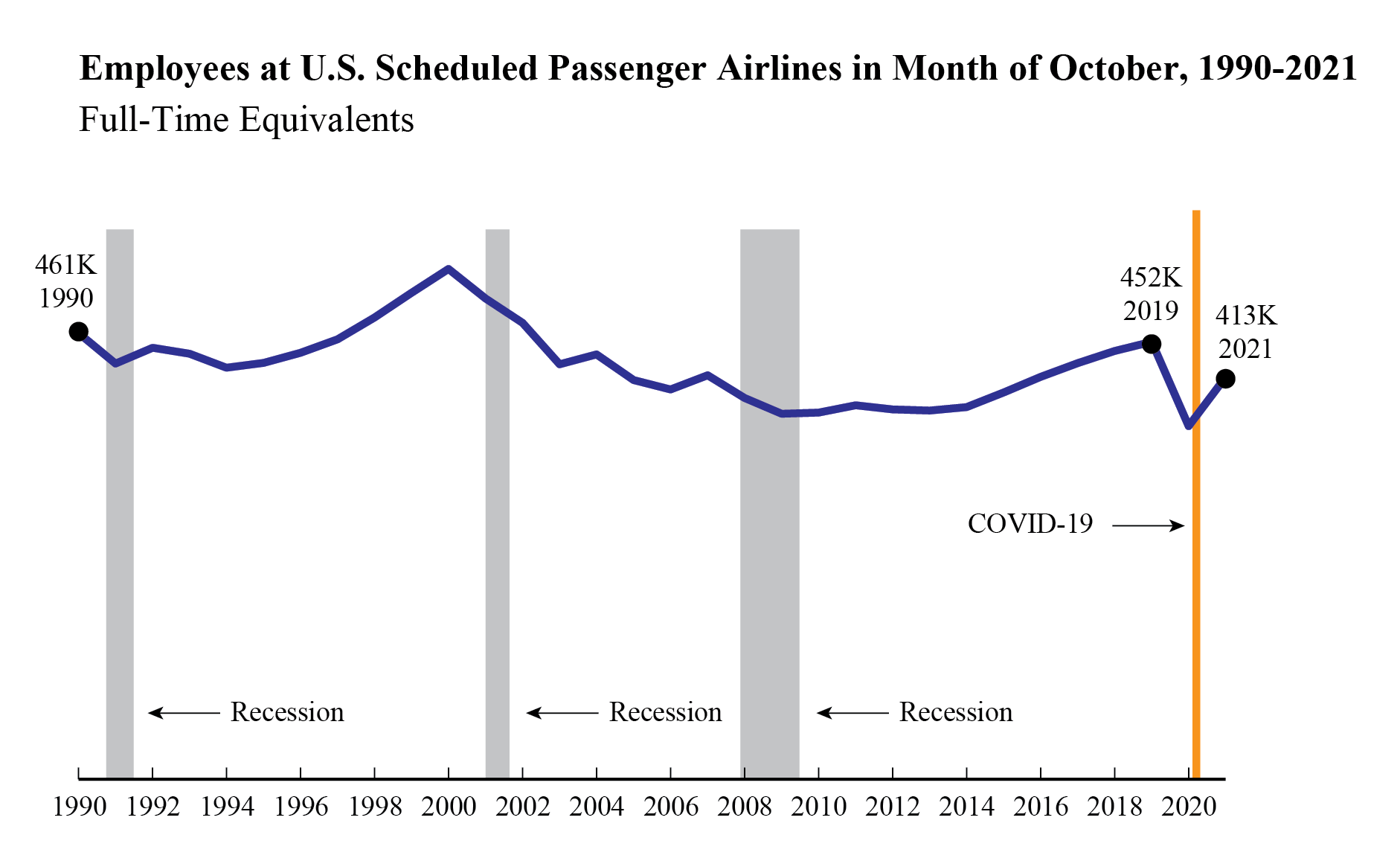Source: US DOT
The 24 U.S. scheduled passenger airlines employed an estimated 412,844 full-time equivalents (FTEs) in October 2021, an increase of 0.5% (2,008 FTEs) from September 2021 (410,836 FTEs). October’s total was down 39,508 FTEs or 8.7% from pre-pandemic October 2019 (452,352 FTEs).
NOTE: This data is estimated because one major passenger carrier has not yet reported its October employment. BTS has imputed data for that carrier based on a 5-month moving average of its full- and part-time employees.
The increase from September resulted largely from Delta Airlines adding 2,701 FTEs, an increase tempered by American Airlines reducing employment by 462 FTEs. Other notable changes include near across-the-board employment reductions among regional airlines (down 446 FTEs) from September to October.
In October 2021, scheduled passenger airlines employed 62% of the total airline industry FTEs, down from 63% at the onset of the pandemic in March 2020. Total industry includes cargo and charter.
Regulations require U.S. airlines to report employment numbers for employees who worked or received pay for any part of the pay period(s) ending nearest the 15th day of the month. U.S. airline employment reports are filed monthly with the Bureau of Transportation Statistics. See the tables that accompany this release on the BTS website for detailed data since 2015 (Tables 1-15) and industry summary monthly data since 1990.

All 24 scheduled service passenger airlines (mid-October)
- 408,680 FTEs
- Down 8.7% (39,508 FTEs) from October 2019 (452,352 FTEs)
- Up 13.1% (47,791 FTEs) from October 2020 (365,053 FTEs)
Four network airlines (mid-October)
American Airlines, Delta Air Lines, United Airlines, Alaska Airlines
- 254,356 FTEs, 62.2% of total scheduled passenger airline FTEs
- Down 11.9% (34,424 FTEs) from October 2019 (288,780 FTEs)
- Up 16.9% (36,840 FTEs) from October 2020 (217,516 FTEs)
- Up 0.9% (2,383 FTEs) from September 2021 (251,973) FTEs
Network airlines operate a significant portion of their flights using at least one hub where connections are made for flights to down-line destinations or spoke cities. Note that beginning with January 2018 data, Virgin America’s numbers are included with Alaska Airlines in the network category.
Six low-cost airlines (mid-October)
Southwest Airlines, JetBlue Airways, Spirit Airlines, Frontier Airlines, Allegiant Air, Virgin America
- 91,544 FTEs, 21.4% of total scheduled passenger airline FTEs
- Down 5.4% (5,238 FTEs) from October 2019 (97,282 FTEs)
- Down 0.1% (109 FTEs) from October 2020 (92,153 FTEs)
- Up 0.9% (786 FTEs) from September 2021 (90,758) FTEs
Low-cost airlines operate under a low-cost business model, with infrastructure and aircraft operating costs below the overall industry average.
Ten regional airlines (mid-July)
SkyWest Airlines, Envoy Air, Piedmont Airlines, Republic Airlines, Endeavor Air, PSA Airlines, Horizon Air, Mesa Airlines, Air Wisconsin Airlines, GoJet Airlines
- 59,079 FTEs, 14.5% of total scheduled passenger airline FTEs
- Up 1.7% (987 FTEs) from October 2019 (58,092 FTEs)
- Up 25.2% (11,895 FTEs) from October 2020 (47,184 FTEs)
- Down 0.7% (446 FTEs) from September 2021 (59,525 FTEs)
Regional carriers typically provide service from small cities, using primarily regional jets to support the network carriers’ hub and spoke systems.
Top Employers by Group
- Network: American 91,544 FTEs
- Low-Cost: Southwest 54,058 FTEs
- Regional: SkyWest 14,548 FTEs
Four other airlines included in industry totals
Other carriers generally operate within specific niche markets. They are Hawaiian Airlines, Sun Country Airlines, Silver Airlines and Eastern Airlines.
